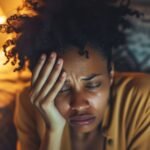From Struggle to Strength: Healing and Embracing Chemo Curls After Cancer
Tanvir Bhamra
February 2025
Unfortunately, one of the most common diseases can be the most destructive; cancer is known as the rapid and uncontrolled growth of mutated cells, and it can happen anywhere in the body. Its risk factors can range from unhealthy lifestyle choices, such as a poor diet and harmful habits, to family history. The experience of having cancer is traumatic in itself, it is not something a person can simply leave behind, as it follows people around like a shadow–survivors would have to learn how to grow and heal from it.
As survivors navigate the challenges of recovery, their bodies undergo various changes—some expected, others surprising. One of the most visible transformations occurs with hair regrowth, revealing an unexpected side effect of chemotherapy: chemo curls.

This occurs because chemotherapy drugs target rapidly dividing cells, including hair follicles. However, many cancer survivors experience a fascinating phenomenon after treatment—when their hair grows back, it often has a completely different texture. Straight hair may turn curly, thick hair may become finer, and some even find their hair changes in color. This transformation is known as “chemo curls.” These curls can range from loose waves to tight ringlets, even if the individual had completely straight hair before treatment. The degree of curliness varies from person to person and the amount of time chemotherapy was given. The hair’s new texture may not be permanent, but for some, chemo curls remain for years after recovery.[3]
The exact cause of chemo curls isn’t fully understood, but researchers believe that changes in hair texture occur due to the way chemotherapy affects hair follicles:[3]
- Disruption of the hair growth cycle: Chemotherapy forces hair follicles into a dormant phase, causing hair loss. When treatment ends, hair follicles begin regenerating, but the process may not return to normalcy immediately.
- Damage to follicle structure: The chemicals used in chemotherapy can alter the structure of hair follicles. If they become slightly misshapen, hair can grow in a different texture.
- Changes in protein bonds: Hair texture is largely determined by keratin, a protein in hair strands. The way keratin bonds form during regrowth may be altered after chemotherapy, leading to curls or waves.
For many, the return of hair is a significant milestone in their recovery, symbolizing a step towards healing. However, the unexpected change in texture can be both surprising and challenging. Some individuals embrace their new curls as a sign of resilience, while others struggle to adapt. People may feel excited at having hair again but frustrated as they navigate caring for a new and unfamiliar texture.
Managing chemo curls requires a different hair care approach post-chemo hair is often sensitive and fragile. Therefore, gentle, hydrating products are recommended. Moisturizing shampoos, conditioners, and curl-enhancing creams can maintain healthy curls. Additionally, avoiding heat styling and using satin pillowcases can reduce frizz and breakage.[2]
The journey through cancer is not just about survival but also about healing and adaptation. Chemo curls, though unexpected, serve as a testament to the resilience of the human body. Whether lasting a few months or years, they represent a new chapter in a survivor’s life. With the right care, mindset, and overall support, individuals can embrace their experiences and continue moving forward with strength and confidence.
References
[1] Donofree, D. (n.d.). Chemo Curls 101: What they are & How to Care for Them. AnaOno. https://www.anaono.com/blogs/dressing-room/chemo-curls-101-what-they-are-how-to-care-for-them?srsltid=AfmBOopSf7LF8tAbw_UXqwu_uPsOfv-kNCF20iFcPEMYkROQSdofqodl
[2] Hair regrowth and Chemo curls after cancer treatment. (n.d.). John Frieda Hair Care – Frizz, Color & Shampoo. Retrieved February 14, 2025, from https://www.johnfrieda.com/en-uk/blog/hair-care/hair-growth-after-cancer-treatment/
[3] Rishe, J. (2021, September 22). Chemo curls: Cause, duration, hair care, and more. MedicalNewsToday. Retrieved February 5, 2025, from https://www.medicalnewstoday.com/articles/chemo-curls#are-they-permanent





